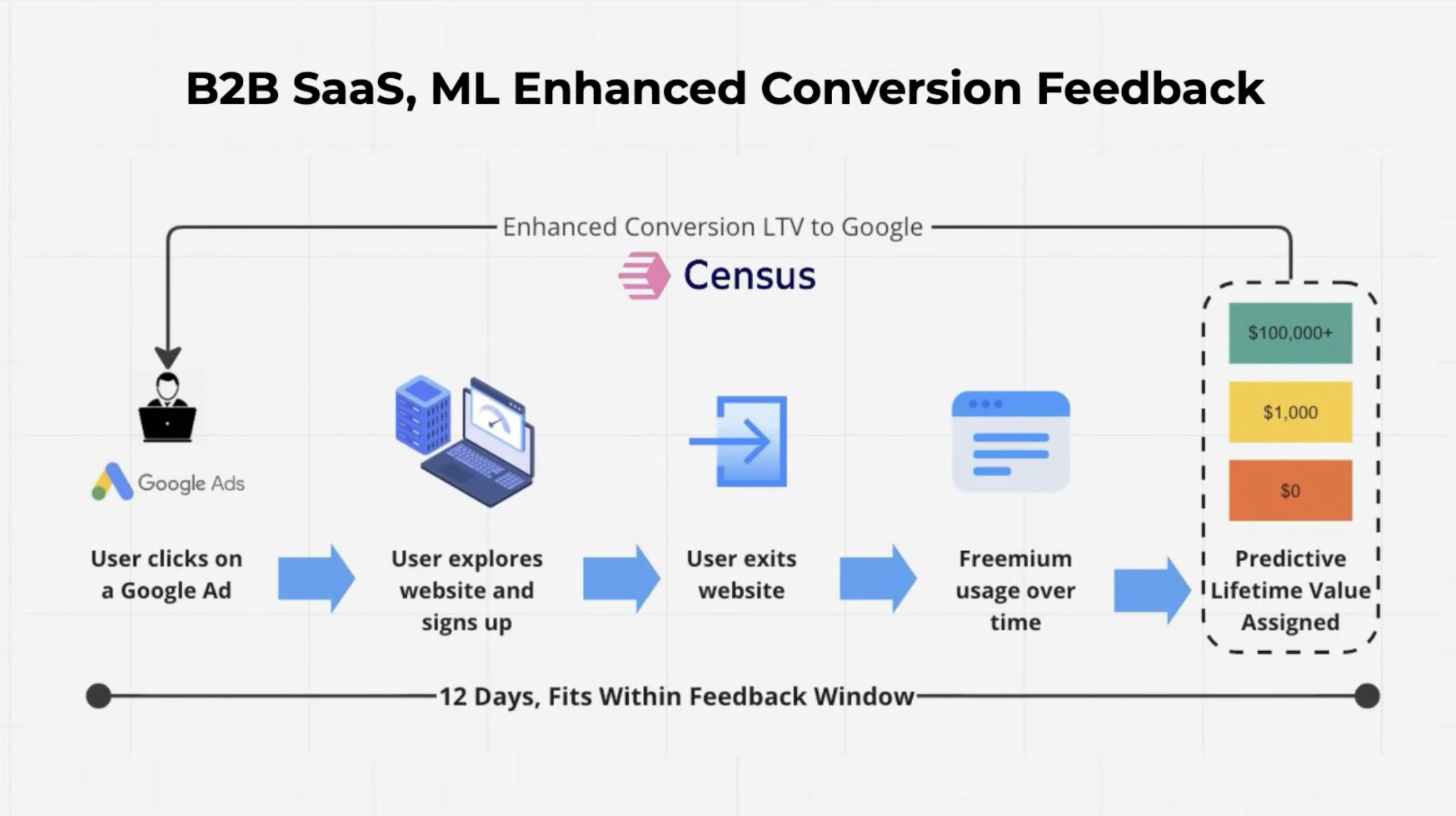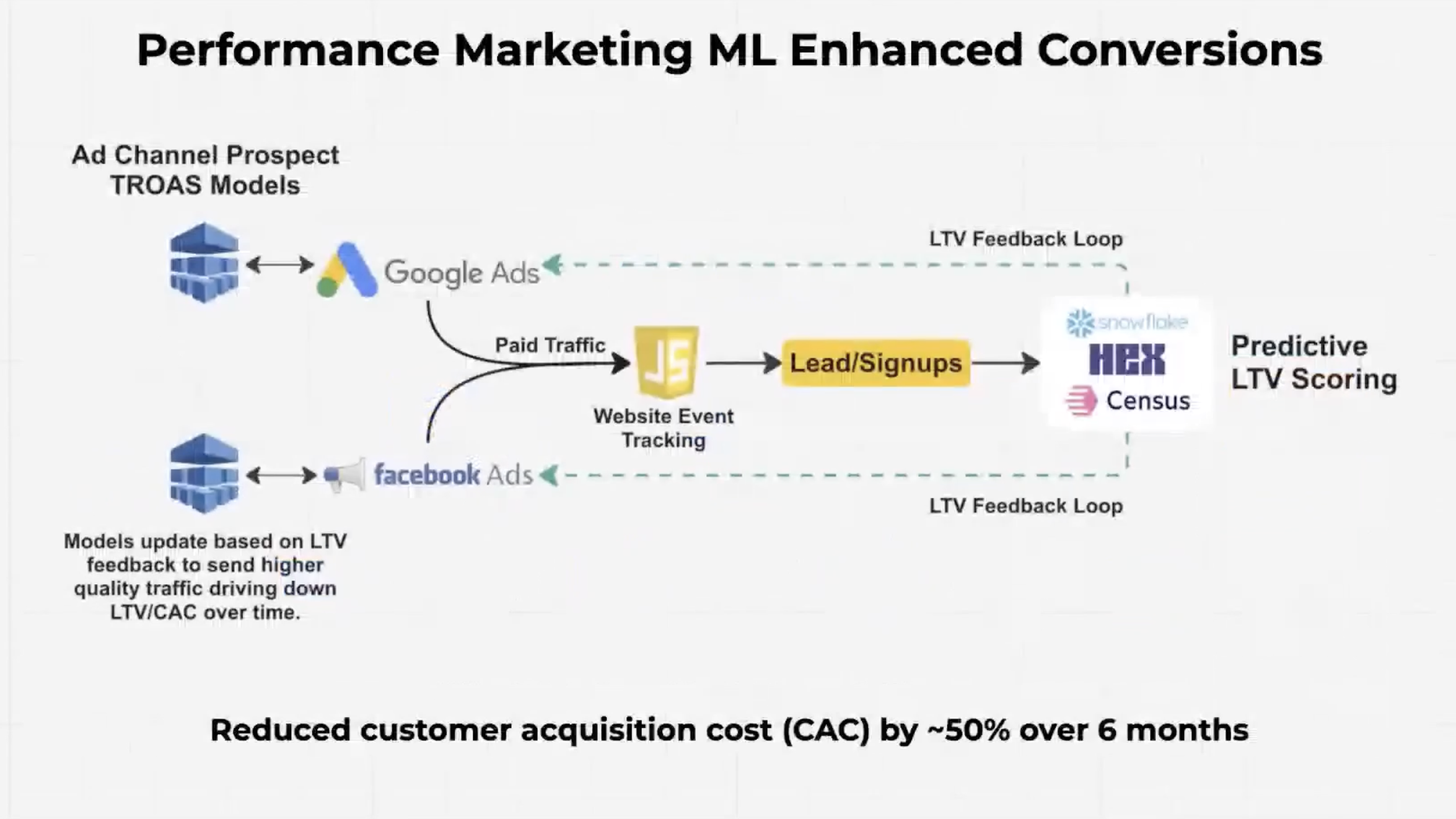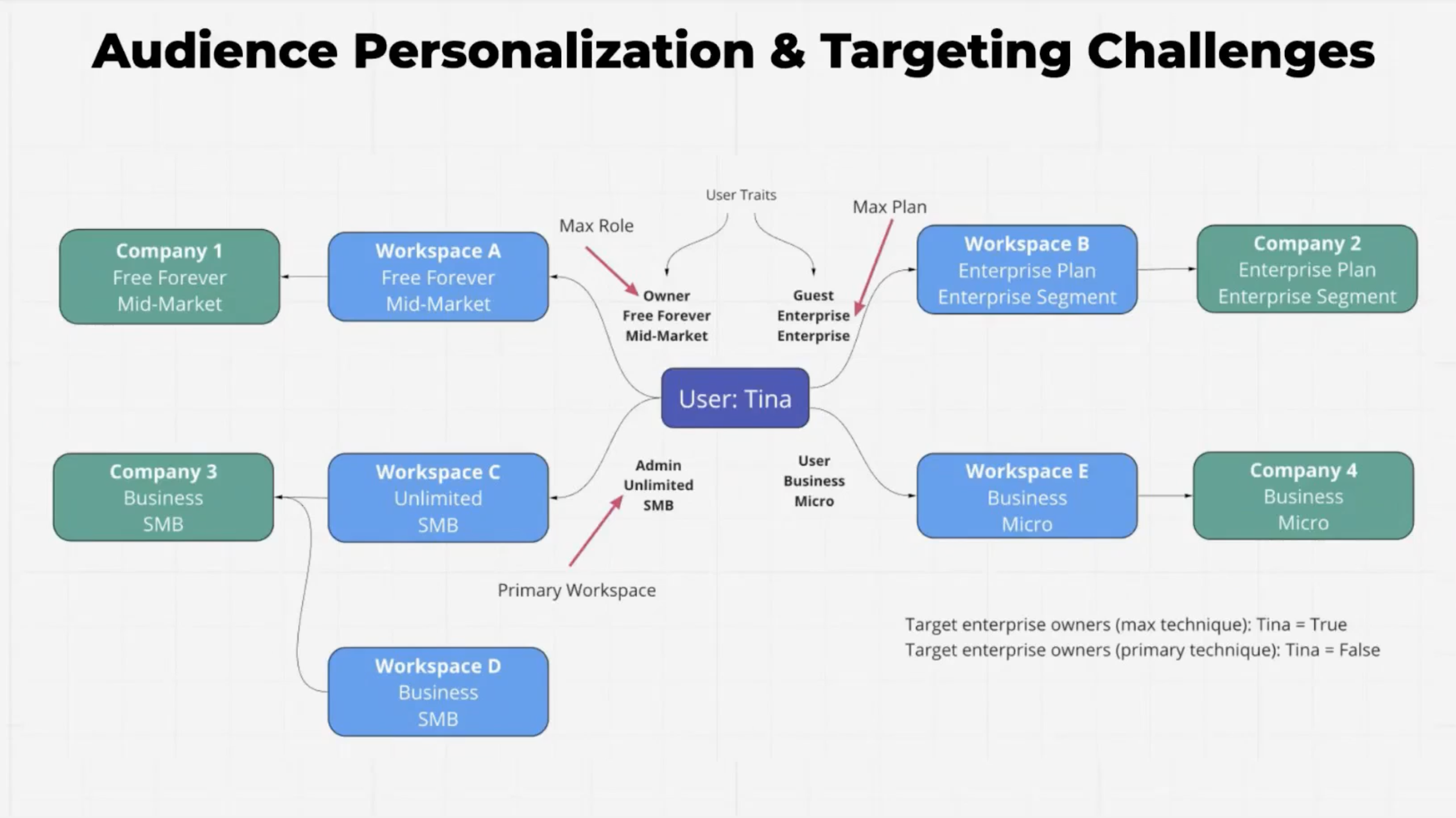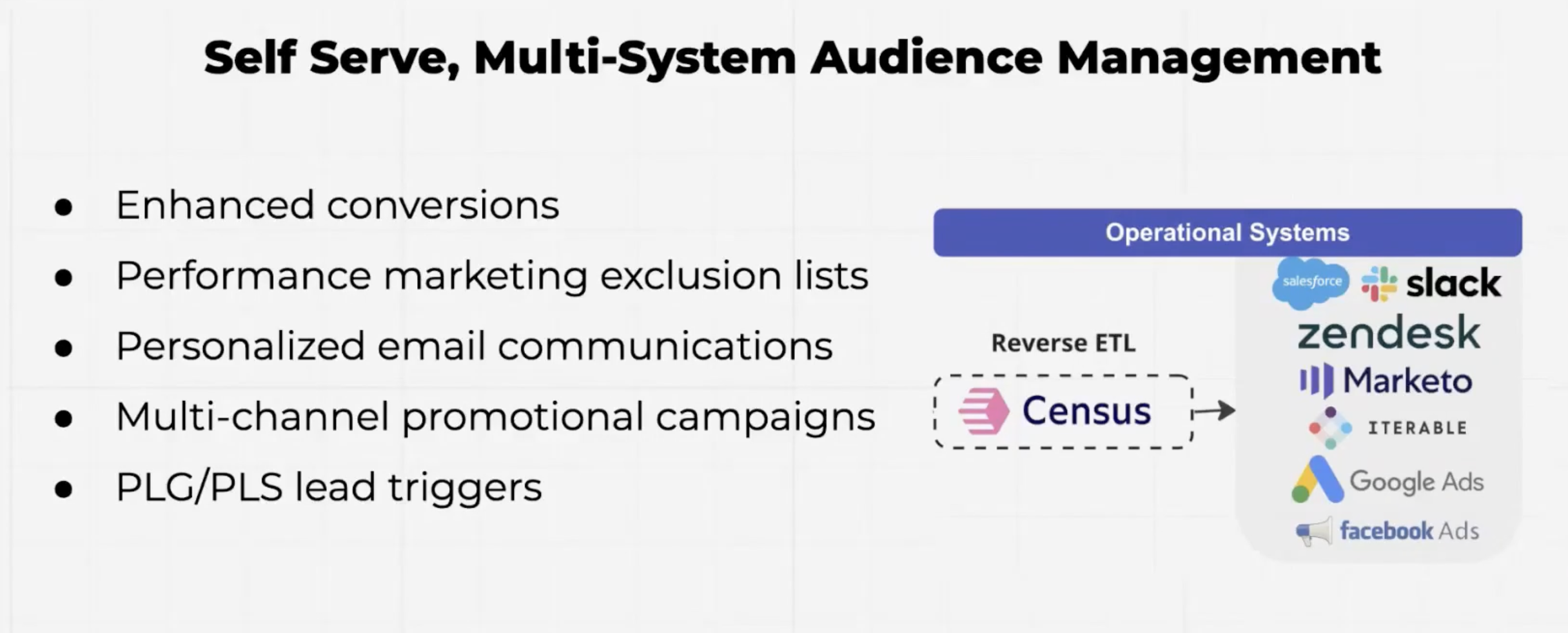CLICKUP X CENSUS
How ClickUp Cut Customer Acquisition Costs by 50% by Activating LTV Models
Marc Stone, VP of Data and Growth at ClickUp, showed how ClickUp implemented a revolutionary approach to Google and Facebook Ads conversion tracking to cut Customer Acquisition Costs by a jaw-dropping 50%.
Using Snowflake and Census at the core of their Composable Customer Data Platform, ClickUp is able to power omnichannel audience management and personalization.
Industry: Product-Led Growth, Productivity tools, SaaS
Headquarters: San Diego, California
Company type: B2B, Product-Led Growth
Team: Data, Growth, Marketing
Use cases: Ad Audiences, Email personalization, Granular Segmentation
Featured integrations: dbt, Facebook Ads, Google Ads, Iterable, Marketo, Slack, Snowflake, Zendesk
ClickUp is a powerful all-in-one productivity platform that brings teams, tasks, and tools together in one place. ClickUp serves over 8 million users across 1.6 million global teams at companies such as Netflix, IBM, T-Mobile, Spotify, TIBCO, and Booking.com.
Results
-
50% reduction in Customer Acquisition Costs over 6 months — ClickUp uses Snowflake, Fivetran, dbt, and Census in their Composable CDP to sync a predictive LTV model that optimizes ad targeting in Google and Facebook.
-
Consistent omnichannel campaigns — ClickUp builds and manages audiences in one central place — Census Audience Hub on top of Snowflake. They can model complex data relationships between users, workspaces, and companies, then make those available to non-technical marketers in a no-code interface.
-
Customer 360 view — ClickUp’s data and marketing teams work together to build comprehensive customer profiles and journeys that unify first-party data. Then, they use Census to send their Customer 360 to any Go-To-Market tool that needs it.
“Census is a big part of how we drive net new business and greatly reduce costs using data. Often you’ll have a multifaceted campaign that needs to target the same users across many different touchpoints. What we’ve been able to do in Census is finally have a system where we can create centralized audiences for all our different platforms and share out that audience to whichever system needs it.”
Marc Stone, VP of Data and Growth
The Challenges
1. Data silos across many Go-to-Market tools
ClickUp’s business teams used multiple platforms to interact with customers, such as CRM, advertising platforms, marketing automation, and customer support tools. Each tool had a slice of customer data, but none had the full picture. ClickUp needed to unify those disparate sources into one single source of truth.
2. Optimizing ad targeting and marketing for Product-Led Growth
As a Product-Led Growth platform, ClickUp needed to comb through millions of free users to figure out which signals indicated high-value users likely to convert to paid customers. To do this, ClickUp needed to provide product behavior data to their business teams to help them optimize ad targeting, identify the best leads, and personalize communications.
“People can use ClickUp for months on end and not end up paying for it until much later, and then they can ramp up their usage very quickly. Waiting months and months and months to give feedback to our ad platforms doesn't optimize very well.”
Marc Stone, VP of Data and Growth

“If you just look at Salesforce activity, you might miss out on ad clicks or interactions with our website. And if you just look at the website and conversion events, you might miss a sales touch in something like Marketo or Salesforce.”
Marc Stone
VP of Data and Growth

The Solution
Building a Customer 360 with first-party data in the data warehouse
ClickUp uses a Composable CDP approach with a cloud data warehouse at the heart of their marketing technology strategy. They aggregate customer data into their data warehouse (Snowflake), create a single source of truth (with dbt), and then serve this first-party data to marketing tools using Census.
ClickUp’s marketing and data teams work together to identify a comprehensive customer profile and journey. By unifying data from as many systems as possible, ClickUp built a Customer 360 that links users across platforms like Iterable for email marketing, Salesforce for sales, Google Ads for spend, and Segment for website interactions.
“We want to monitor all the interactions that anyone has with our business, regardless of what system that interaction occurs in. Data warehouses [like Snowflake] are uniquely great at aggregating cleaned events from all over your stack. And while you can use a lot of stuff like CDPs, the advantage of having the warehouse be the core is you can correct past mistakes and attribution errors and improve the quality of your data over time.”
Marc Stone, VP of Data and Growth
Use Case #1:
Optimized ad campaigns = 50% Reduction in Customer Acquisition Costs
Google and Facebook Ads have powerful machine learning algorithms to help marketers get the lowest cost per click and boost conversions. But their ML models need input on high-value conversions to maximize ROAS on your behalf.
When you provide the platforms with better information, the results are transformational. Using Census to feed Google and Facebook Ads with first-party data from Snowflake, ClickUp cut its customer acquisition costs by 50% in just six months.
ClickUp’s biggest challenge was timing. They only had about 14 days after the ad click to optimize a Google campaign to get the full advantage of the platform’s machine learning power.
“You could use ClickUp for nine months and not send a conversion,” Marc said. “But we can use the data warehouse and some advanced functionality to overcome that challenge and supercharge our marketing to greatly lower the cost structure.”
Instead of waiting months for a paid conversion, ClickUp’s data team works with their marketing team to use predictive modeling to optimize their ad targeting.
- First, they predict the expected Lifetime Value (LTV) of an individual workspace “owner” using data from the user’s first 12 days of activity and demographic data.
- They store these predictions directly in Snowflake as part of a customer’s unified profile.
- Then, they use Census to send the expected LTV values to Google and Facebook Ads as conversion values, which optimize the campaign that generated the lead.
“None of this relies on the user’s browser or cookies, and we get a much higher quality match over time,” Marc explained.


Use Case #2:
Personalized email outreach and Omnichannel Audience Management
Marketing personalization is deceptively challenging, particularly in a company like ClickUp where a single user can belong to multiple workspaces. Imagine a hypothetical user who is an admin of a free ClickUp workspace, but also belongs to a paid enterprise workspace as a guest.
If your martech platform can’t keep track of those relationships, you could send the user an email meant for the admins of a paid enterprise plan, resulting in a confusing or frustrating experience.
“Modeling this out and creating audiences in a system like Customer.io or Iterable or Marketo gets very complex. A relational database and a data warehouse is perfectly built to handle this sort of a challenge.” — Marc Stone, VP of Data and Growth

ClickUp models their customer data in Snowflake using dbt, and then the Census Audience Hub to build audiences without code. Powered by Census, ClickUp supercharges email personalization by defining customer data and audience segments in one central place, and then managing those audiences across email, advertising, and even sales channels.

“Often you’ll have a multifaceted campaign that needs to target the same users across many different touchpoints. What we’ve been able to do in Census is finally have a system where we can create centralized audiences for all our different platforms and share out that audience to whichever system needs it.”
Marc Stone, VP of Data and Growth
Looking Forward
ClickUp is a great example of how data teams can drive growth and impact the business’s bottom line.
“The data team becomes a more active player in the business than somebody who's just creating dashboards or reporting on KPIs,” said Marc. “We're directly improving our sales and marketing teams.”
Marc is excited to find more ways to leverage ClickUp’s data to its fullest potential. His team will continue to fine-tune customer profiles, experiment with more granular customer segmentation, refine their LTV models, and scale Data Activation to as many areas as possible to further optimize business operations.
Ready to take your data-driven marketing strategy to the next level? Get a free onboarding of Census today.
From your data warehouse to all your apps, customers, and agents.
Without code or CSVs.
Start using Census today by booking a demo with one of our experts.

















